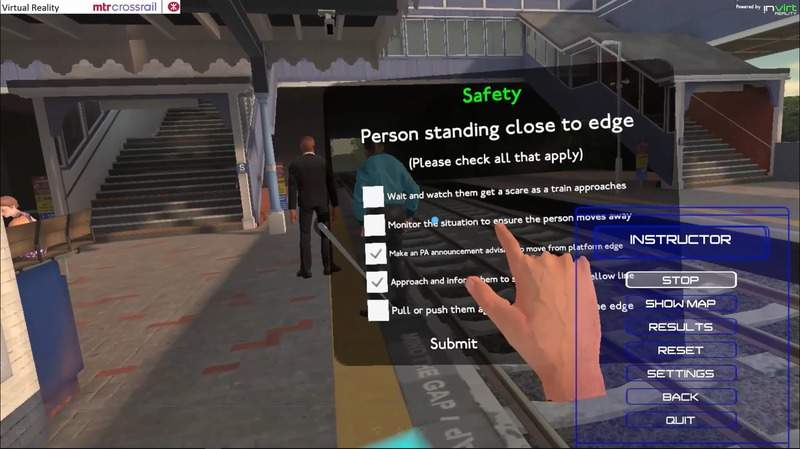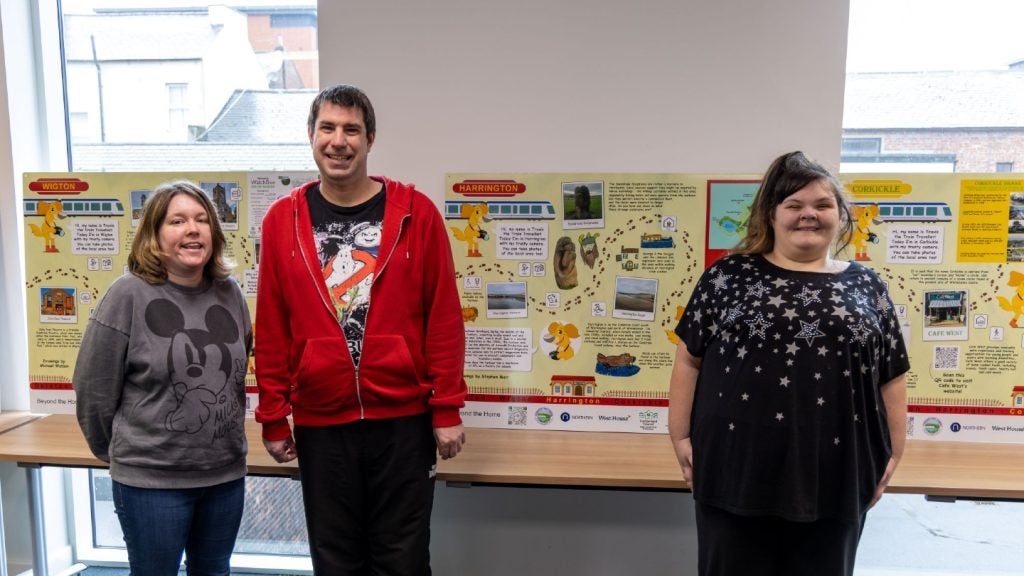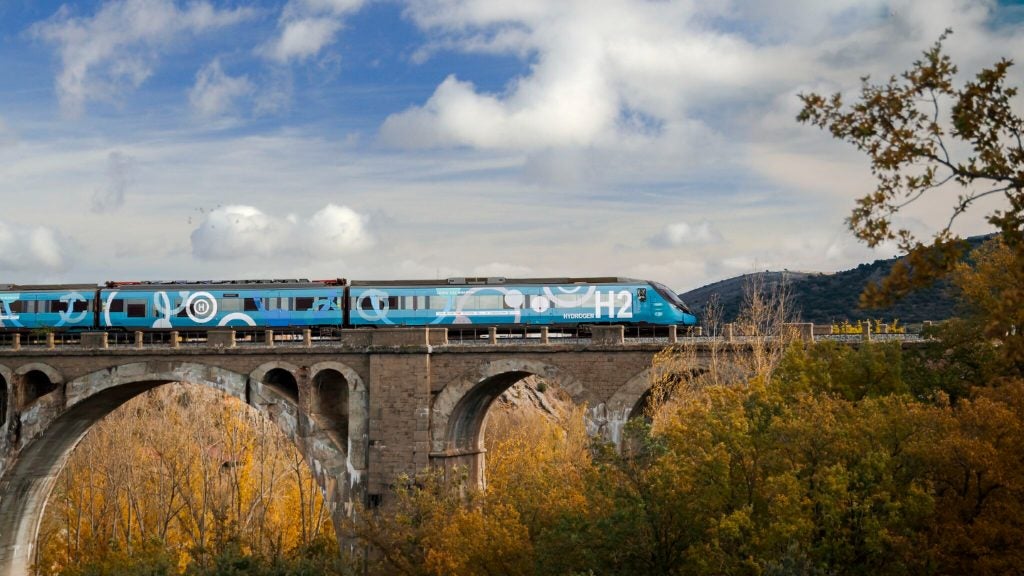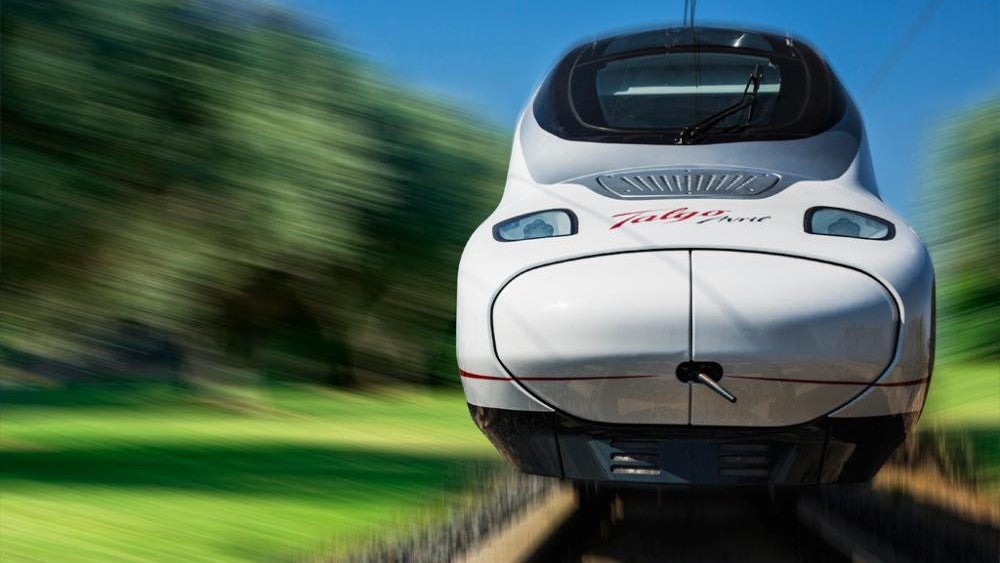
The strength of a new railway depends not only on fancy new infrastructure and trains, but on competent staff keeping things running smoothly at stations. To enhance its training programme, Elizabeth Line train operator MTR Crossrail looked to the world of virtual reality (VR) and introduced a platform simulator that will allow new employees to put their skills to the test in a computer-generated train station.
Built in conjunction with technology specialist Invirt Reality and using the HTC Vive VR system, the platform allows trainee staff to walk around and interact with objects using movements and arm gestures. Training is staged across a number of scenarios, from reporting faults on critical station equipment, to dealing with safety hazards that would be too dangerous to replicate in real life.
VR has already been deployed elsewhere in the rail industry, including numerous aspects of Crossrail’s construction. However, MTR Crossrail finance director Andy King says that the application of VR to station staff training is a leading step for the UK’s rail sector, and one that other operators might look to utilise in the future.
Joe Baker: What is the VR station concept, and how did it come about?
Andy King: In the rail industry, train drivers always have simulators where they combine virtual learning with real route learning. Our IT team was looking into whether we could introduce VR training for station staff.
We started to look at what we could use as a proof of concept which wouldn’t be replicating what we’ve already done. It would be an enhancement to training, as opposed to a novelty, and we struck on the idea of actually building a virtual station and using that as a platform for training.
Typically, staff will spend some time in a real station environment and they’ll do some classroom learning and that was about it. What we wanted to do is make something a bit more immersive and a bit more interactive for our staff.
How well do you really know your competitors?
Access the most comprehensive Company Profiles on the market, powered by GlobalData. Save hours of research. Gain competitive edge.

Thank you!
Your download email will arrive shortly
Not ready to buy yet? Download a free sample
We are confident about the unique quality of our Company Profiles. However, we want you to make the most beneficial decision for your business, so we offer a free sample that you can download by submitting the below form
By GlobalDataThere are some studies that demonstrate that VR use in training leads to a better retention of knowledge [amongst participants]. VR is more immersive and more involved, and so can actually can give you a bit more than ‘death by PowerPoint’ stuff. So we developed a bog-standard station, and then we started looking at different aspects from our business.
JB: What technology has been used, and how does the platform work in practice?
AK: The technology is quite simple; it’s an HTC Vive running on a PC in a room with a cohort of trainees. One person will be on the system and the others can actually watch what they are doing in it from a training point of view.
The HTC Vive is fully immersive, so you put on the headset and you’ve got a controller in each hand. There’s a small defined space you can walk around in, and you move with the avatar in the environment. If you turn, crouch down or stand up, the environment moves with you as if you were actually stood there. Using the controllers, you can see your hands in the environment, reach out, put a ticket through a ticket gate or pat a call button on a lift.
JB: Are the virtual station environments based on real stations?
AK: That’s a very interesting question! One of the ones we’ve got in there at the moment is based loosely on Seven Kings station. But one of the challenges we’ve got is whether we should build stations that replicate what we’ve already got in reality. If you do that, you might get some people who complain that things aren’t exactly right, and that could detract from the training, but on the flip side it would be quite good to train on a station where someone’s going to be based and actually have the right layout.
The key focus isn’t that you’ve got that bin or that poster board in the wrong place. We want people to really focus on the different scenarios they’ll come across so we’re trying to make generic stations based on one of ours – as opposed to a full replica of a station.
JB: What are the main safety/security issues covered in the training?
AK: Firstly, we’ve got some very customer-focused regimes in terms of what our stations look like, so we’ve got some really tight key performance indicators to make sure there’s no graffiti, rubbish or any of that stuff.
We’ve got faults that lie in the environment, so you’ll walk around, see something on the floor, and get a question popping up saying “what are you going to do?”. There’s a right answer and there’s plenty of wrong answers. You choose one and then you get marks off the back of that.
But then there are things that are less easy to do in a real environment. From a safety point of view we’ve got all sorts of common things, such as puddles of water, sharp objects and broken glass on the floor. In one of our scenarios there’s a bin on fire at the station.
You’ve also got behavioural things for passengers – there might be someone running on a platform – or someone walking round with a ladder when you’ve got wires overhead. We can put things in there that in reality are very unsafe, but you can actually do it in a safe environment where you can walk up to the avatar, question them, and figure out what’s the best course of action.
Then you have the security side, and the same premise applies. In a railway station, you’ve got different protocols for what’s hidden, obvious and typical. We’ve got certain security things in the environment – bags under benches, something hidden in a bush, those sorts of things. You need to walk through and ask whether it is something you’d typically expect to find.
JB: How will this be incorporated into existing training methods?
AK: As the Elizabeth Line gets closer, we’re taking on new stations and more staff. Last year, we took on new stations between Paddington and Heathrow along with Abbey Wood, and there were about 70 staff transferred to us. They all went on this training as part of their induction. So it’s not going to replace the classroom-based stuff; it’s [designed] to supplement it.
With the opening of full Elizabeth Line services by December 2019, we’re recruiting about another 150 staff to the stations. They have just started coming on board, and will all be going through [the VR training] as well.
We’ve got a dedicated training floor in our head office, with two thirds of the floor committed to training facilities. There are seven classrooms with one of those set up for VR training. It’s not something that is going to be running 9-5 every single day. It’s going to be used depending on when their course is, so it’s flexible.

JB: How are you looking to expand the system in the future?
AK: It would be remiss of us to sit on our hands. We’ve got something which, at the moment, I think is quite leading for the UK industry, so to sit there and go ‘we’re done now’ would be an oversight.
We’ve got one well-developed National Rail station platform, and are in the process of developing an underground station, which we should have in the next month or two. As technology moves on, we are improving visuals to make sure it looks as realistic as possible.
HTC have recently released a version of the Vive that allows you to have two people in the same environment at the same time. I think this would be a genuinely useful development because of the fact that you’ve got people who work on stations together actually walking around together. You can also take on different roles – there’s nothing to say you can’t take on the role of a customer and see a different side of things.
We’re not just developing for development’s sake. We’re looking at very specific improvements to actually supplement the critical safety security protocols and the quality of the station, and we’re looking at what else we can do to focus on the customers.
JB: How do you think the role of VR will evolve in the future with regards to rail training?
AK: There is one thing that I think is immensely powerful for VR. Quite a lot of train companies are spread out geographically. The VR kits you see in demos can probably be put it in a holdall with a powerful laptop. Instead of having everyone come to a training centre, it’s transferrable. So you move away from being relatively geographically constrained from a training centre, where everyone’s got to come to you, or you’ve got to go to a train simulator – a very big piece of kit that’s in one place.
If you start looking at things virtually, you could send your training team out with a wheelie bag with the room scalers in it, the headset and the powerful laptop. It gives you a whole different area that you could actually operate in.
JB: What has been the reaction to the VR training so far?
AK: Some people love it, while some people are saying ‘oh I don’t really fancy that’. But the ones who don’t fancy putting on a headset and wandering around a virtual station can watch other people do it. So it’s a learning experience both ways.
They will all get experience of it on different levels, but on balance almost everyone has been really engaged and wanting to have a go.






